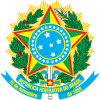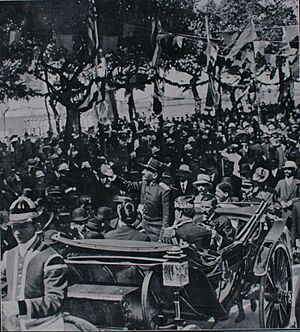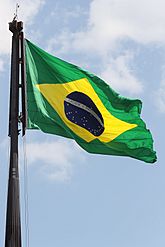President of Brazil facts for kids
Quick facts for kids President of the Federative Republic of Brazil |
|
|---|---|

|
|

|
|
| Federal government of Brazil | |
| Style |
|
| Member of | Cabinet National Defense Council Council of the Republic |
| Residence | Palácio da Alvorada Granja do Torto |
| Seat | Palácio do Planalto |
| Appointer | Direct popular vote (two rounds if necessary) |
| Term length | Four years,
renewable once consecutively
|
| Constituting instrument | Constitution of Brazil (1988) |
| Precursor | Emperor of Brazil (as Head of State) Prime Minister of Brazil (as Head of Government) |
| Inaugural holder | Deodoro da Fonseca |
| Formation | Proclamation of the Republic November 15, 1889 |
| Succession | Line of succession |
| Deputy | Vice President |
| Salary | R$ 402,151/US$ 76,309 annually |
The president of Brazil (Portuguese: presidente do Brasil) is the main leader of the country. This person is both the head of state and the head of government of Brazil. The president is in charge of the executive branch of the federal government. They are also the commander-in-chief of the Brazilian Armed Forces, meaning they lead the military.
Brazil became a republic in 1889 after a military change. Before that, it was an empire. Since then, Brazil has had different rules and periods of democracy and other types of government. The Constitution of Brazil is the main rulebook. It explains what the president can do, how long they serve, and how they are chosen.
Luiz Inácio Lula da Silva is the 39th and current president of Brazil. He started his term on January 1, 2023.
Contents
What the President Does
Brazil is a republic where the president has a lot of power. The president leads the government and represents Brazil to other countries. They also choose people for important jobs, like the cabinet members. With approval from the Senate, they also appoint judges for the highest court. The president is also the top leader of the armed forces.
Brazilian presidents can also help create laws. They can suggest new laws to the National Congress. They can also use something called Medidas Provisórias (provisional measures). These are like temporary laws that the president can make in urgent situations.
A provisional measure starts working right away, even before Congress votes on it. It stays in effect for up to 60 days. This period can be extended to 120 days. If Congress approves it, it becomes a permanent law. If Congress rejects it, or if the time runs out, the provisional measure stops being a law.
The Constitution of Brazil lists many important jobs for the president:
- Choosing and removing government ministers.
- Managing the federal government with help from ministers.
- Starting the process for new laws.
- Approving and announcing laws, and making rules to enforce them.
- Stopping bills from becoming laws (vetoing them).
- Changing how the federal government is organized, as long as it doesn't cost more money or create new agencies.
- Working with other countries and their leaders.
- Signing international agreements, which the Congress must approve.
- Declaring a state of defense or a state of siege in emergencies.
- Ordering federal intervention in certain situations.
- Sending a message to Congress at the start of each year about the country's situation.
- Granting pardons or reducing sentences for people.
- Leading the armed forces and appointing their commanders.
- Appointing judges and other important officials with Senate approval.
- Appointing members to special councils.
- Calling and leading the Council of the Republic and the National Defense Council.
- Declaring war if Brazil is attacked, with Congress's approval.
- Making peace, with Congress's approval.
- Giving out awards and honors.
- Allowing foreign forces to be in Brazil temporarily, if needed.
- Sending plans for the country's budget to Congress.
- Reporting to Congress each year about the government's finances.
- Creating and removing federal government jobs.
- Issuing provisional measures.
- Doing other duties listed in the Constitution.
How the President is Chosen

Who Can Be President?
To become president of Brazil, a person must meet certain requirements:
- They must be born in Brazil.
- They must be at least 35 years old.
- They must live in Brazil.
- They must have full voting rights.
- They must be a registered voter.
- They must belong to a political party. People who are not part of a party cannot run.
How Long is a Term?
The president of Brazil serves for four years. They can be re-elected for one more term right after their first. However, this limit is not for life. A former president who served two terms in a row can run again after at least one term has passed.
If the vice president or another official takes over as president, even for a short time, they can only be elected or re-elected once. This is because the two-term limit still applies to them. Vice presidents often act as president when the president travels outside Brazil.
Running for Other Jobs
If a president (or governor or mayor) wants to run for a different political job, they must leave their current office at least six months before the election day.
History of Terms
The rule allowing a president to be re-elected was added to the Constitution in 1997. Before that, presidents could not be immediately re-elected. The only exception was during a period from 1937 to 1945. Also, until 1937, only men could be president. The 1988 Constitution first set the presidential term at five years, but it was changed to four years in 1994.
President's Pay and Benefits
| Presidential styles of Luiz Inácio Lula da Silva |
|
|---|---|
 |
|
| Reference style | Senhor Presidente da República "Mr. President of the Republic" |
| Spoken style | Senhor Presidente or Presidente "Mr. President" or "President" |
The president receives a monthly salary. They also have money for expenses like travel and other needs while in office. In Brazil, employees usually get an extra payment each year, like a "thirteenth salary." So, the president receives 13 payments per year.
The Palácio do Planalto in Brasília is where the president works. The Palácio da Alvorada is their official home. The president can use the staff and facilities at these places. The Residência Oficial do Torto, also known as Granja do Torto, is a ranch outside the capital. It's used as a country getaway. The Palácio Rio Negro in Petrópolis is a summer retreat, but it's not used very often. The vice president lives at the Jaburu Palace in Brasília.
The government has also set up "Regional Offices of the Presidency" in some major Brazilian cities. These are not homes, but fully staffed offices. They are ready for the president and ministers to use when they are in those cities. For example, there's an office in São Paulo. Other regional offices are in Porto Alegre and Belo Horizonte.
For travel on the ground, the president uses a special armored car. For ceremonial events, like Independence Day, a 1952 Rolls-Royce Silver Wraith is used. The main presidential aircraft is a military version of an Airbus A330-200. Smaller jets are used for shorter trips. When the president is on board, these planes are called "Brazilian Air Force One". Helicopters are also used for presidential travel.
Images for kids
-
Presidential helicopter (VH-34 and VH-36)
Removing a President from Office
A president can be removed from office through a process called impeachment. First, two-thirds of the Chamber of Deputies must agree to bring charges against the president. If they do, the Senate then decides whether to investigate. If the Senate agrees to investigate, the president is suspended from their duties for up to 180 days.
During this time, the vice president takes over. If the trial is for "common criminal offenses," it happens at the Supreme Federal Court. If it's for "crimes of malversation" (misconduct in office), the trial takes place at the Federal Senate. If the trial doesn't end within 180 days, the president returns to office. If the president is found guilty, they are removed from office, and the vice president becomes the new president.
Crimes of malversation include actions against:
- The existence of Brazil as a country.
- The proper functioning of the government branches (Legislative, Judicial).
- People's political and individual rights.
- The country's internal safety.
- Honesty in government administration.
- Budget laws.
- Following laws and court decisions.
After Being President
Former presidents are given certain benefits by law:
- They receive permanent security protection.
- They can use two official vehicles for the rest of their lives.
- They get funding for a presidential library to keep their records.
- Their widows and unmarried daughters receive a monthly pension for life.
- Their sons receive a pension until they become adults.
List of Presidents
All presidents of Brazil have been called President of the Republic. This title has been used since Brazil became a republic in 1889. The country's official name changed over time. From 1889 to 1937, it was "Republic of the United States of Brazil." From 1937 to 1967, it was "The United States of Brazil." So, presidents during those times had a longer official title. Since March 15, 1967, the country's official name has been "Federative Republic of Brazil." Since then, all presidents have been called President of the Federative Republic of Brazil.
Most Recent Election
| Candidate | Running mate | Party | First round | Second round | |||
|---|---|---|---|---|---|---|---|
| Votes | % | Votes | % | ||||
| Luiz Inácio Lula da Silva | Geraldo Alckmin (PSB) | Workers' Party | 57,259,504 | 48.43 | 60,345,999 | 50.90 | |
| Jair Bolsonaro | Walter Braga Netto | Liberal Party | 51,072,345 | 43.20 | 58,206,354 | 49.10 | |
| Simone Tebet | Mara Gabrilli (PSDB) | Brazilian Democratic Movement | 4,915,423 | 4.16 | |||
| Ciro Gomes | Ana Paula Matos | Democratic Labour Party | 3,599,287 | 3.04 | |||
| Soraya Thronicke | Marcos Cintra | Brazil Union | 600,955 | 0.51 | |||
| Luiz Felipe d'Avila | Tiago Mitraud | New Party | 559,708 | 0.47 | |||
| Kelmon Souza | Luiz Cláudio Gamonal | Brazilian Labour Party | 81,129 | 0.07 | |||
| Leonardo Péricles | Samara Martins | Popular Unity | 53,519 | 0.05 | |||
| Sofia Manzano | Antonio Alves | Brazilian Communist Party | 45,620 | 0.04 | |||
| Vera Lúcia Salgado | Kunã Yporã Tremembé | United Socialist Workers' Party | 25,625 | 0.02 | |||
| José Maria Eymael | João Barbosa Bravo | Christian Democracy | 16,604 | 0.01 | |||
| Total | 118,229,719 | 100.00 | 118,552,353 | 100.00 | |||
| Valid votes | 118,229,719 | 95.59 | 118,552,353 | 95.41 | |||
| Invalid votes | 3,487,874 | 2.82 | 3,930,695 | 3.16 | |||
| Blank votes | 1,964,779 | 1.59 | 1,769,668 | 1.42 | |||
| Total votes | 123,682,372 | 100.00 | 124,252,716 | 100.00 | |||
| Registered voters/turnout | 156,454,011 | 79.05 | 156,454,011 | 79.42 | |||
| Source: Superior Electoral Court (first round), Supreme Electoral Court (second round) | |||||||
See also
 In Spanish: Presidente de Brasil para niños
In Spanish: Presidente de Brasil para niños
- List of presidents of Brazil
- Brazilian presidential inauguration
- Politics of Brazil
- Cabinet of Brazil
- Vice President of Brazil
- Brazilian Air Force One
- Presidential Guard Battalion (Brazil)












